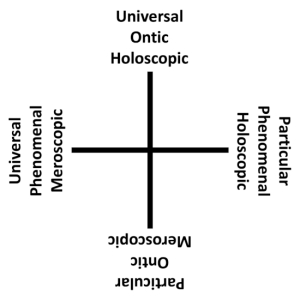The duals in Richard McKeon’s system of Philosophical Semantics can also be arranged in a three-dimensional tetrahedron, where the dual pairs are on opposing edges. The universal and particular methods, the phenomenal and ontic interpretations, and the meroscopic and holoscopic principles are shown above.
Universal methods, between knower and knowledge, are applicable to all problems and all subject matters. Particular methods, between the knowable and the known, require distinct methodological procedures for different problems or subject matters.
Holoscopic principles, looking at or seeing the whole, provide a coincidence of knowledge and known. Meroscopic principles, looking at or seeing the parts, separate the knower and the knowable from each other and from influence between each other.
Ontic interpretations, between the knowable and knowledge, derive their character from a reality assumed to transcend or to underlie phenomena and statements. Phenomenal interpretations, between knower and the known, may reduce reality and values to aspects or consequences of phenomena.
Alternatively, the four vertices of knower, knowledge, known, and knowable can be labeled by their method, principle, and interpretation as shown below.
http://en.wikipedia.org/wiki/Richard_McKeon
[*6.136]
<>



4 thoughts on “Richard McKeon’s Aspects of Knowing, Part 2”